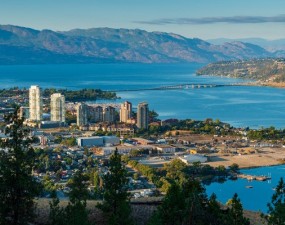Keeping Kelowna Moving, Now and into the Future
Topics
May 28, 2024
As one of the fastest growing communities in Canada, transportation infrastructure is top of mind for Kelowna residents, businesses, and our organization. In fact, transportation, including traffic mobility, is one of our six 2023–2026 Council Priorities—key focus areas that help guide our investment decisions to increase quality of life, now and in the future.
Our 2040 Transportation Master Plan, sets ambitious but achievable targets and goals to achieve our vision of a vibrant city where people and places are conveniently connected by diverse transportation options. To measure our progress in these and other areas, we recently released the Year 1 2023–2026 Council Priorities Progress Report. It includes eight key transportation measures, and highlights some key actions we took throughout the year. We invite residents to check it out at council.reporting.kelowna.ca and learn more about what we’re doing, how we’re doing, and where we will be focusing our efforts in 2024 and beyond.
One of the things we’re working on this year is accelerating an approximately $60 million-dollar investment to deal with capacity and congestion on our important network roads. This includes improvements for all modes of travel from our active transportation (walk/bike) network, expanding transit exchanges, and optimizing capacity and traffic flow on major road corridors with innovative technological solutions.
Responding to our city’s rapid growth not only includes planning, designing, and building new transportation infrastructure but also operating existing infrastructure more efficiently. Below are a few additional projects we’re currently working on this year.
Breaking ground on Bertram pedestrian overpass
Improving traffic flow and increasing trips by alternative transportation modes are two of the City’s key transportation objectives. A major construction project supporting this is the Bertram Multi-use Overpass over Highway 97, which broke ground on March 8, 2024. Designed to the latest standards, the overpass will be accessible for all ages and abilities, safer for pedestrians, cyclists, and micro-mobility users, and improve traffic flow with the elimination of two crosswalks on the highway.
Expanding our active transportation network and transit services
We are in an exciting phase of our citywide active transportation initiatives as we work toward connecting our network. In addition to the Bertram overpass, we now have a cycling corridor all the way down Ethel Street past Okanagan College onto Casorso Road. The City is in the process of extending the network along Sutherland Avenue. The network is a great option for walkers and cyclists, including micromobility users, looking for a more comfortable commuting alternative for recreational activities.
Our transit system is also proposed to expand by 15 per cent in the next three years with increased service hours and more capacity. And we are even piloting on-demand transit in southeast Kelowna and are in the planning stages for a new transit garage that will be built near UBCO.
Taking a fresh look at road construction
Because central Okanagan is a busy construction market, we are taking a fresh look at procurement by advancing and combining larger road construction projects into packages to attract larger contracting companies. Using this approach, we can get roads built faster, and at a slightly lower overhead cost with no loss in quality. And while we are finding more efficient ways for road construction, it is not our only solution to relieve traffic congestion. The first step is to use Kelowna’s existing road infrastructure as efficiently as possible.
Using technology to improve traffic flow
One option the City is reviewing to optimize our existing roads is an innovative, new traffic detection solution for traffic signals which may be piloted on one of Kelowna's traffic corridors in the near future. This technology has the potential to adjust traffic in real-time as opposed to relying on pre-programming. If successful, this will allow for traffic to flow better meaning drivers can save time and idle less, lowering emissions.
To learn more about the transportation Council Priority, including what we're doing, how we're doing, and what's coming up next, visit council.reporting.kelowna.ca and kelowna.ca/transportation.







